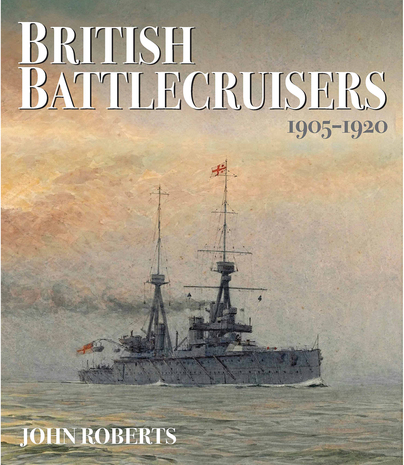
British Battlecruisers 1905-1920. By John Roberts. Seaforth Publishing, Barnsley, 2016. ISBN 978-1-4738-8235-5
UK price £35.00.
Reviewed by David Hobbs
JOHN Roberts is one of the foremost experts on British capital ship design and this is a revised and improved edition of a book he first published in 1997. Two decades of further research and reflection have led to a number of improvements, the most obvious being the incorporation of 14 coloured ‘as fitted’ drawings of the battlecruisers HMS INVINCIBLE and HMS PRINCESS ROYAL reproduced from the National Maritime Museum’s archive at the ‘Brass Foundry’ in Woolwich. Five of these open out into a four-page gatefold and all are printed to a high quality that allows compartment names and their contents to be read with a magnifying glass (the originals are over 3 metres long). They include hull cross sections, deck plans and profiles which give an almost three-dimensional, understanding of the two ships. The author is also a noted draughtsman and has contributed several of the 18 sets of black and white drawings that support the text together with many of the 75 black and white photographs. A complete set of black and white plans of HMS QUEEN MARY are included in a pocket inside the back cover.
Rather than describe battlecruisers by class, Roberts describes their evolution in chapters covering different aspects, each of which contributes to an understanding of the changes from the beginning of work on HMS INVINCIBLE, the first battlecruiser, in 1905 to the completion of HMS HOOD, the last, in 1920. There are, therefore, details of HMAS AUSTRALIA spread throughout the book, including several photographs and a detailed drawing of one of her Twin BVIII gun turrets with its two 12-inch Mark X 45 calibre guns on page 80. Successive chapters describe battlecruiser origins, design and construction, machinery, armament including the operation of aircraft from turret-top platforms and armour protection. Comparisons are made with German ships and, for those who wish to carry out further research of their own, the author’s sources, including ships’ covers, are listed together with footnotes.
The text describes Admiral Fisher’s original concept of deploying battlecruisers over long distances at high speed to intercept and destroy commerce-raiding cruisers. This led to the procurement of HMAS AUSTRALIA and her fleet unit and was demonstrated by the Royal Navy’s deployment HM Ships INVINCIBLE and INFLEXIBLE to defeat Von Spee’s armoured cruisers off the Falkland Islands in 1914. However, Roberts believes that effectively Fisher’s idea resulted in a hybrid type with excellent short-term prospects but of dubious long-term value, especially when eventually confronted by warships with similar armament, including battleships.
In the first edition, the author concludes that the overall policy that led to the evolution of the battlecruiser was seriously let down at a detail level. Reviewed with the benefit of hindsight, he took the view that it was a type that should not have been built although it was not of inherently flawed design. His conclusions in the new edition are more thought-provoking and he goes more deeply into the question of detail, observing that it was not so much the design of the ships that was at fault as their ammunition and the security of its supply to the guns. He certainly pulls no punches in his final paragraph, stating his opinion that ‘if the British battlecruisers had not been built then neither would those of Germany…there is, of course, no reason to believe that the naval war in the North Sea would then have progressed any differently but this in itself says much about the true value of the battlecruiser’.
Battlecruisers were among the fastest and certainly most expensive warships ever built but there have always been differing opinions over their role and effectiveness. This is one of the most informative and thought-provoking books ever written about them and I have no hesitation in thoroughly recommending it. Even if you already have a copy of the first edition, I would still recommend purchasing a copy of the new edition; the coloured ‘as fitted’ drawings alone would be worth the investment and the deeper text a significant improvement.



